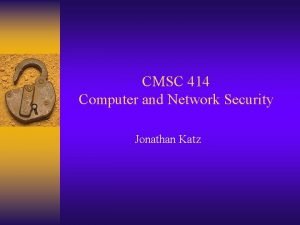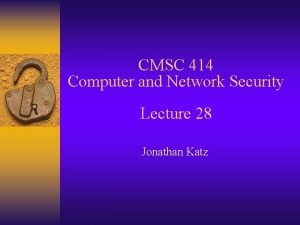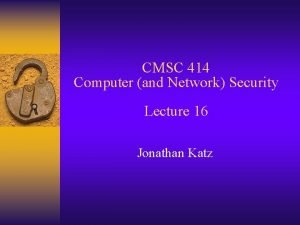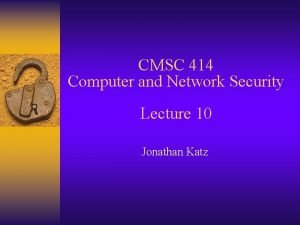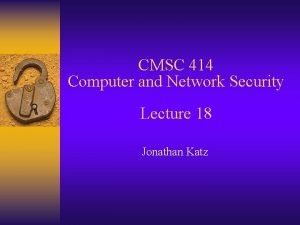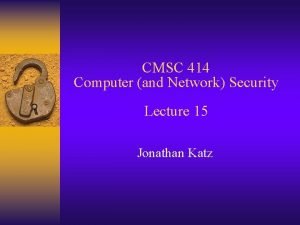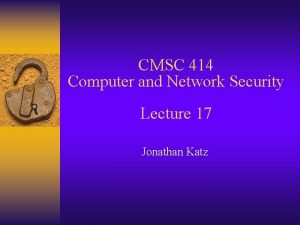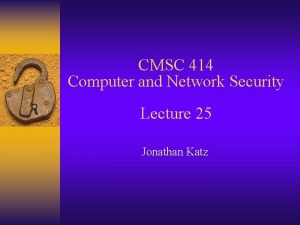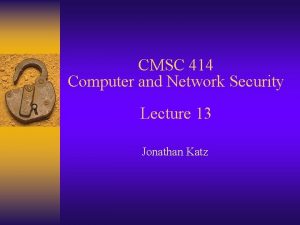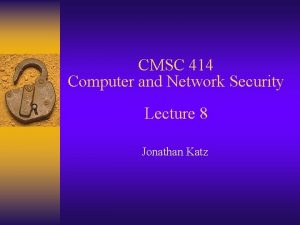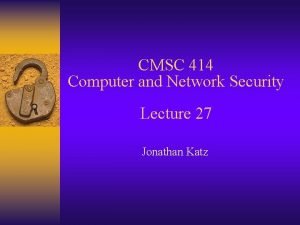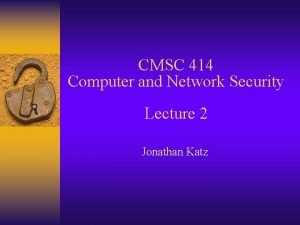CMSC 414 Computer and Network Security Lecture 8













- Slides: 13

CMSC 414 Computer and Network Security Lecture 8 Jonathan Katz

“Why Cryptosystems Fail” ¨ Limited disclosure of crypto failures… ¨ Insider attacks – By bank clerks, maintenance engineers, … – Poor prevention/detection mechanisms – Poor key management – Insecure delivery of ATM cards/PINs ¨ Reduced entropy of PINs ¨ Use of “home-brewed” encryption schemes

One system #, PIN Account # ATM PIN ok Bank If FK(#) = PIN: return “ok” This is similar, but not identical, to how ATMs work today

Attacks ¨ Sniff PIN; get account # from discarded receipt – Solution: don’t print full account # on receipt ¨ Replay “ok” message! – Solution: use authentication with replay protection ¨ Impersonate an ATM to a customer – Can this be prevented without implementing crypto on the ATM card? (Hint: how can the bank authenticate directly to the user? )

Another system Account # c=Enc. K(PIN) #, c, PIN ATM PIN Bank ok If DK(c) = PIN: debit account #, return “ok” No binding between account # and PIN!

Another system encrypted Account # PIN ATM # balance withdraw amt If. Ifamt ≤ balance, FK(#) = PIN: dispense cash “authenticated” Do you see an attack? Bank

“Insecurity of 802. 11” ¨ WEP encryption: IV, RC 4(IV, k) (M, checksum(M)) ¨ Is this secure against chosen-plaintext attacks? – It is randomized… – But how is the IV chosen? • Only 24 bits long • Reset to 0 upon re-initialization • Some implementations increment the IV as a counter – IV repetitions are a problem! ¨ 40 -bit key (in early version)

“Insecurity of 802. 11” ¨ Known-plaintext attacks – Based on header information, known message blocks, etc. ¨ Chosen-plaintext attacks – Send IP traffic/e-mail to the mobile host – Transmit broadcast messages to access point – Authentication spoofing

“Insecurity of 802. 11” ¨ No cryptographic integrity protection – The checksum is linear (i. e. , c(x y) = c(x) c(y)) and unkeyed, and therefore easy to attack ¨ Encryption used to provide authentication – Allows easy spoofing after eavesdropping – Allows IP redirection attack Chosen-ciphertext attacks! – Allows TCP “reaction” attacks • Look at whether TCP checksum is valid

“Analysis of E-Voting System” ¨ This paper should scare you… – Magnitude of possible attacks by voters – Not just the security flaws, but also the reaction of Diebold and govt. officials… ¨ Vulnerable to attacks by voters, as well as attacks by insiders ¨ Security through obscurity did not help – In this case, code was leaked

Overview ¨ Voting terminals initialized; ballots installed ¨ On voting day, voters given voting card – Voter inserts card, gets ballot, makes choices – After confirmation, voting card is “cancelled” ¨ Election is closed by inserting an admin card – Results can be uploaded for tabulation

“Analysis of E-Voting System” ¨ Poor cryptography – Smartcards have no cryptographic functionality • Possible to create home-made voting cards! – No cryptographic protection for admin cards • Only a weak PIN…if any • Possible to shut down the election! – No cryptographic protection against multiple voting • Disable “cancellation”, or overwrite card – Improper audit mechanism for detecting over-voting

“Analysis of E-Voting System” ¨ Poor/missing cryptography… – Most data stored without any integrity • Potentially possible to modify ballot or even the software – No authentication of data sent to back-end server – Hard-coded, non-random DES key! • Used for multiple versions!! – CBC mode with IV = 0! • Problems with deterministic encryption… • Linking voters to votes (encrypted votes stored sequentially) – CRC used instead of a MAC – Poor random number generation
 Cmsc414 umd
Cmsc414 umd Cmsc 414
Cmsc 414 Cmsc 414
Cmsc 414 Cmsc 414
Cmsc 414 Computer security 161 cryptocurrency lecture
Computer security 161 cryptocurrency lecture Wireless security in cryptography
Wireless security in cryptography Privatesecurity
Privatesecurity Computer and network security
Computer and network security Osi security architecture model
Osi security architecture model Guide to network security
Guide to network security Electronic mail security in network security
Electronic mail security in network security Security guide to network security fundamentals
Security guide to network security fundamentals Security guide to network security fundamentals
Security guide to network security fundamentals 01:640:244 lecture notes - lecture 15: plat, idah, farad
01:640:244 lecture notes - lecture 15: plat, idah, farad
